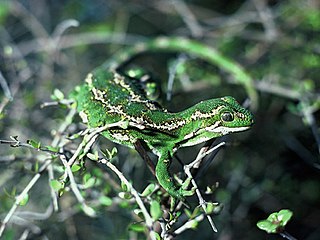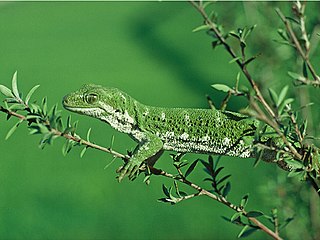
Hoplodactylus is a genus of geckos in the family Diplodactylidae. The genus is endemic to New Zealand, one of the seven genera of geckos found only in New Zealand. Hoplodactylus comprises two species of large to gigantic brownish lizards.

Naultinus is a genus of geckos that are endemic to New Zealand. On account of their striking colouration, species in the genus Naultinus are commonly known as green geckos. There are nine described species in the genus. Species in the genus share a number of traits that set them apart as quite different from the rest of the world's two thousand odd gecko species, which are generally brown in colour, ovivaparous, short-lived and nocturnal. In contrast, Naultinus are green, ovovivaparous, live up to 30 years or more and are strictly diurnal. New Zealand has a temperate, maritime climate, and in terms of distribution Naultinus is one of the southernmost gecko genera in the world — some species live in habitats in the South Island which receive regular snowfall in winter. Animals in this genus possess several physiological and behavioural adaptations to cope with these periods of low temperatures and adverse weather.

The Northland green gecko, also known commonly as Gray's tree gecko is a species of lizard in the family Gekkonidae. The species is found only in the Northland region of New Zealand, north of Whangaroa, and is one of the rarest and most highly sought after lizards.

Duvaucel's gecko is a species of lizard in the family Diplodactylidae. The species is endemic to New Zealand and regarded as 'at risk' by the New Zealand Department of Conservation (DOC) due to distribution limitations.

The Wellington green gecko is a species of gecko found only in the southern half of the North Island of New Zealand. It was previously considered a subspecies of the Auckland green gecko, and together called the common green gecko.

The New Zealand striped skink is a rare species of medium-sized skink endemic to New Zealand. Found in the North Island, Great Barrier Island and Little Barrier Island, the species is primarily arboreal, living in dense native tree canopies.

The rough gecko is a species of gecko in the family Gekkonidae native to New Zealand. It is endemic to the Kaikōura Ranges.

The jewelled gecko is a threatened species of lizard in the family Diplodactylidae. The species is endemic to the South Island of New Zealand.

The Marlborough green gecko, also known as the manuka gecko, is a small species of gecko endemic to New Zealand. It grows to a maximum of 70mm, and is green, with some individuals displaying gold markings. The underside of the gecko is a lighter green in females, and silvery in males. The holotype is in the collection of the Museum of New Zealand Te Papa Tongarewa.

The Nelson green gecko or starred gecko is a species of the family Gekkonidae (gecko). The neotype is in the collection of the Museum of New Zealand Te Papa Tongarewa.

The West Coast green gecko is a species of the family Gekkonidae (gecko).

The forest gecko is a species of gecko that is endemic to New Zealand. Its Māori name is moko pirirākau. It is found in all parts of the country except the Far North and Canterbury. It is a protected species under the Wildlife Act 1953.

Woodworthia maculata, also known as the New Zealand common gecko or Raukawa gecko, is a species in the family Diplodactylidae. The species is endemic to New Zealand.

Dactylocnemis pacificus, the Pacific gecko or Pacific sticky-toed gecko, is a species in the family Gekkonidae, endemic to the North Island and offshore islands of New Zealand. D. pacificus is the only described species in the genus Dactylocnemis, but five offshore island forms may represent new species, one of which is the Mokohinau gecko.

The Tākitimu gecko is an endemic species of gecko in the family Diplodactylidae found in the Southland region of New Zealand. Tākitimu gecko were first described by Jewell and Leschen in 2004 as Hoplodactylus cryptozoicus.

The ornate skink is a rare species of skink endemic to New Zealand. Once widespread across the North Island, habitat destruction and predation by introduced species has now reduced their range to scattered localities throughout the North Island and offshore islands.

The Aupōuri green gecko, also known as the North Cape green gecko or yellow-lipped green gecko, is a species of gecko in the family Diplodactylidae. While the existence of the species was known for many years, it was undescribed until early 2021, with its scientific name being Naultinus 'North Cape' prior to description as N. flavirictus.

The korowai gecko, also known as the Muriwai gecko, is a gecko found on the west coast of the Auckland Region of New Zealand. First discovered on Oaia Island in 1954, the species was recognised as distinct from Woodworthia maculata in 2016, and was formally described in 2023. Only 32 individuals are known to exist as of 2023, all within a very restricted range, on Te Korowai-o-Te-Tonga Peninsula, Muriwai Beach, Muriwai Regional Park and Oaia Island.

The Mokohinau gecko is an undescribed species of gecko found in the Mokohinau Islands, 100 km (62 mi) north of Auckland in the Auckland Region of New Zealand.




















